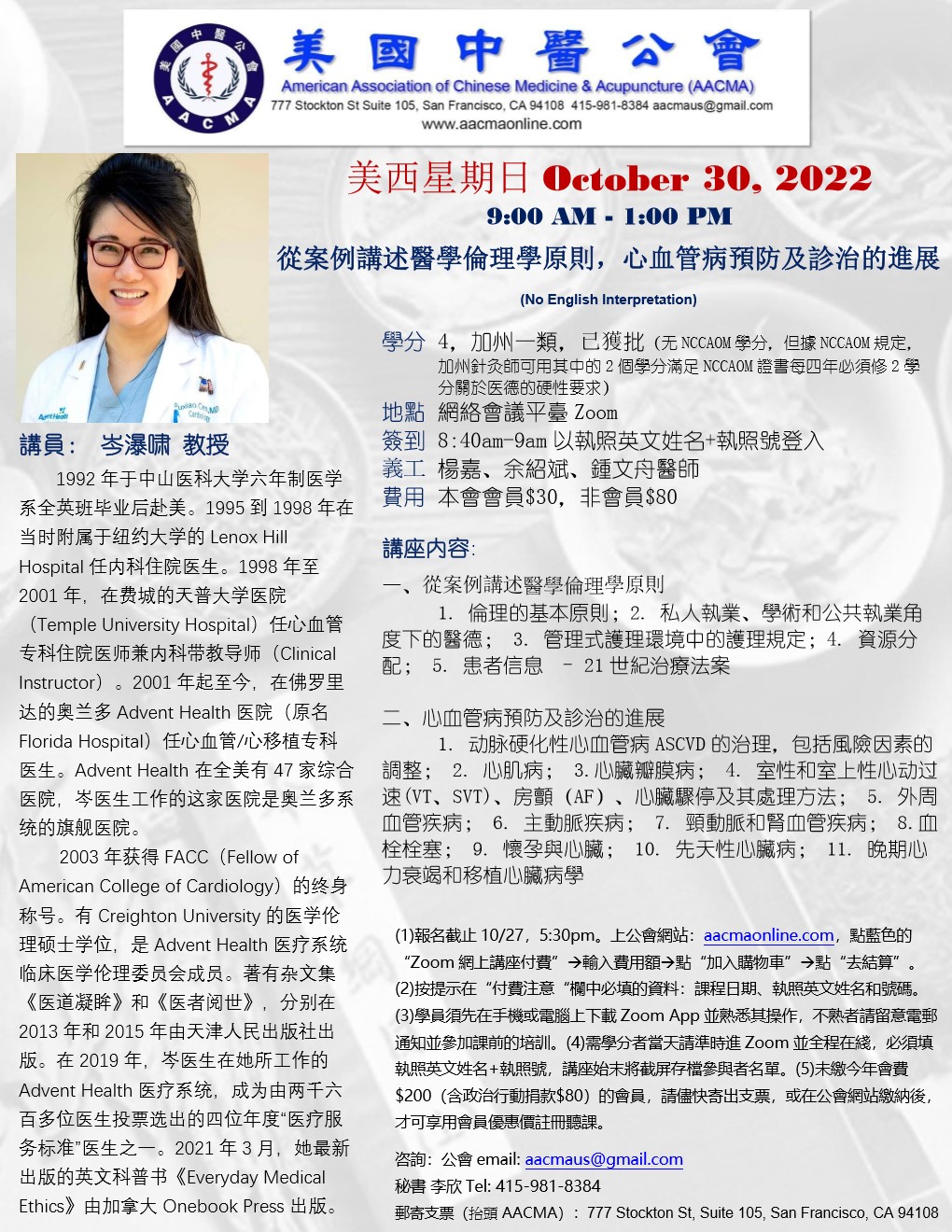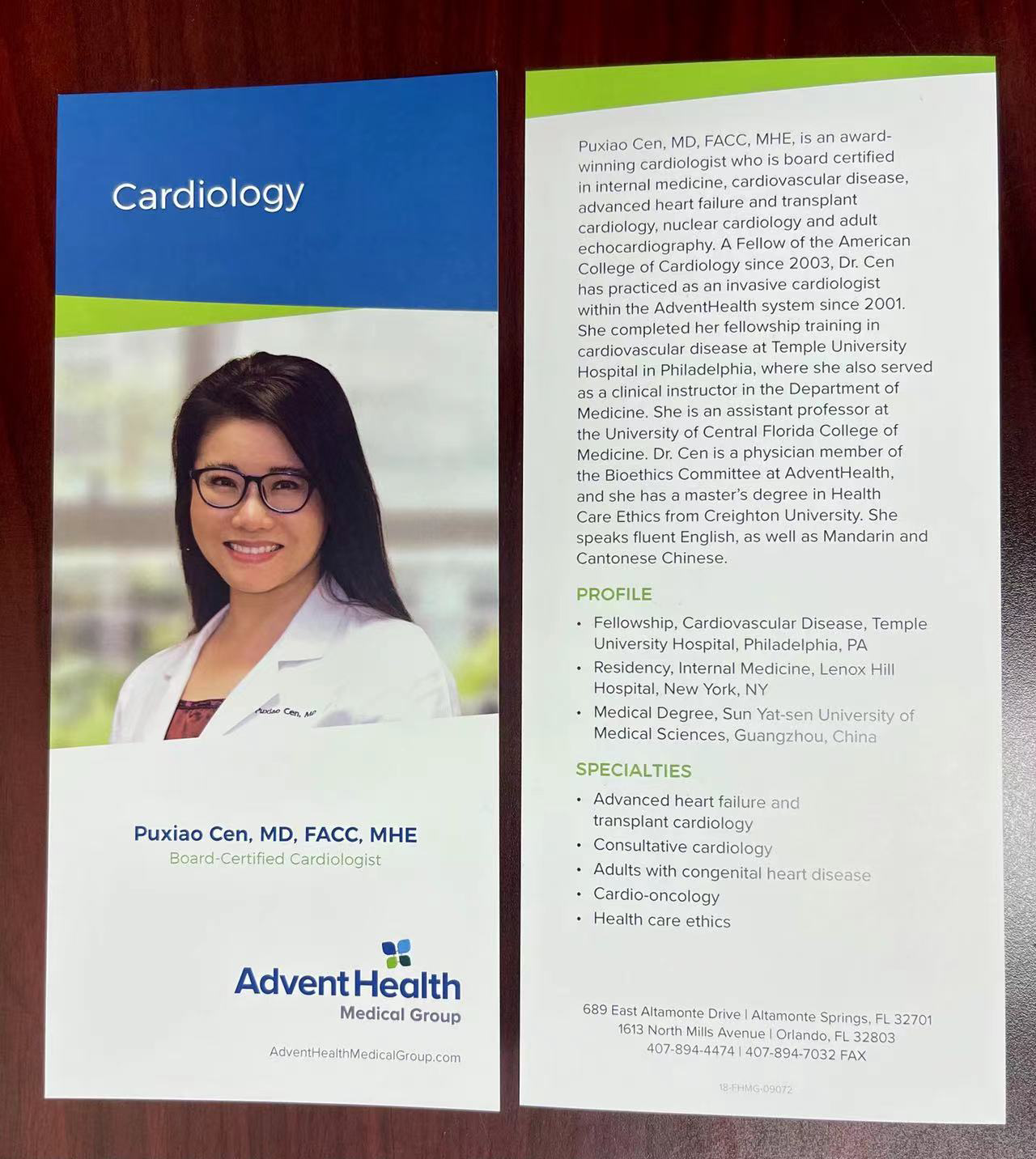(No English interpretation)
時間:美西星期天9am-1pm(其它時區請自行換算)
地點:網絡會議平臺Zoom
義工:杨嘉、余紹斌、鍾文舟医师8:30am前登入
簽到:8:40am-9am以執照英文姓名+執照號登入
費用:會員$30,非會員$80
4個加州一類學分已获批。无NCCAOM學分,但據NCCAOM規定,加州針灸師可用其中的2個學分滿足NCCAOM證書每四年必須修2學分關於醫德的硬性要求。
(1)報名截止10/27,5:30pm。上公會網站:aacmaonline.com,點藍色的“Zoom網上講座付費”,輸入費用額,點“加入購物車”,點“去結算”。按提示必填電話及有效電子郵箱,以發送上課密碼。在“付費注意”欄中按提示必填:講座日期、執照英文姓名和號碼。
(2)學員須先在手機或電腦上下載Zoom並熟悉其操作,不熟者請留意電郵通知並參加課前的培訓。
(3)需學分者當天請準時進Zoom並全程在綫,必須填執照英文姓名+執照號,講座始末將截屏存檔參與者名單。
(4)未繳今年會費$200(含政治行動捐款$80)的會員,請儘快寄出支票,或在公會網站繳納後,才可享用會員優惠價註冊聽課。
咨詢:公會email:aacmaus@gmail.com 李欣 秘書,Tel:415-981-8384
郵寄支票(抬頭AACMA): 777 Stockton St, Suite 105, San Francisco, CA 94108
10/30/2022繼續教育講座内容介紹(英文)
岑瀑啸教授– 從案例讲述医学伦理学原则, 心血管病预防及诊治的进展
1. Healthcare Ethics from a Private Practice Viewpoint, 2 hours
COURSE DESCRIPTION
This cardiology overview course is designed for those who want to stay on top of established evidence and guidelines in cardiology. This course will give you a learning curriculum that will give enable you to bring the most current medical knowledge back to your daily practice.
COURSE LEARNING OBJECTIVES:
Upon completion of this review course, participants should be able to:
Apply current management strategies to the primary and secondary prevention of CAD, including therapies to reduce risk factors and appropriate counseling on lifestyle changes;
Describe and choose among treatment options for rhythm control in atrial fibrillation, including medications, cardioversion, and ablation;
Recognize the presentation, select appropriate testing, and choose effective management options for patients with valvular diseases;
Develop a comprehensive approach to the clinical evaluation of patients with congestive heart failure;
Describe the etiology and pathophysiology of dilated, hypertrophic, restrictive cardiomyopathies and use this information to effectively diagnose and manage patients with these disorders.
TARGET AUDIENCE
This course is intended for licensed acupuncturists.
Content
1. ASCVD management, including modifications of risk factors, eg. obesity, diabetes, hypertension, smoking;
2. Cardiomyopathies;
3. Valvular heart Disease;
4. AF, SVT, VT, cardiac arrest and their management pathways;
5. Peripheral Vascular Disease;
6. Diseases of the Aorta;
7. Carotid and Renal Vascular Disease;
8. Thromboembolism;
9. Pregnancy and the Heart;
10. Congenital Heart Diseases;
11. Advanced Heart Failure and Transplant Cardiology.
2. Overview and state of the art of cardiovascular care, 2 hours
COURSE DESCRIPTION
This healthcare ethics overview course is designed for those who want an introduction to the current issues confront in private medical practice. This course will give you a learning curriculum that will enable you to bring the most current medical knowledge back to your daily practice.
COURSE LEARNING OBJECTIVES:
Upon completion of this review course, participants should be able to:
Explain the foundational principles of healthcare ethics through a careful examination of the practice environment.
Apply healthcare ethics principles to clinical cases involving ethical decision-making.
Describe the different factors that present ethical challenges in private, academic and public practice of medicine.
Recognize the ethical dilemmas confronted in private practice medicine and ways to avoid them.
TARGET AUDIENCE
This course is intended for licensed acupuncturists.
Content
Healthcare Ethics from a Private Practice Viewpoint
1. Foundations of Ethics
a. Biomedical Ethics – Principlism
b. Utilitarian vs deontological ethics in medicine
2. Private Practice vs Academic and Public Practice
a. Impact of “For-profit” label on perception of Private Practice
b. Ethical Concern – Conflict of interest
c. Self-referral and autonomy of choice for patients in the context of clinics owned by physicians
d. Cherry-picking and inequity of care
3. Care provision in a managed care environment
4. Resource Allocation
a. Misuse of resources
b. PPE, treatment allocation and patient safety during COVID
c. Ordering tests and procedures – profit vs liability mitigation
5. Patient information – 21st Century Cures Act
6. Conclusion


